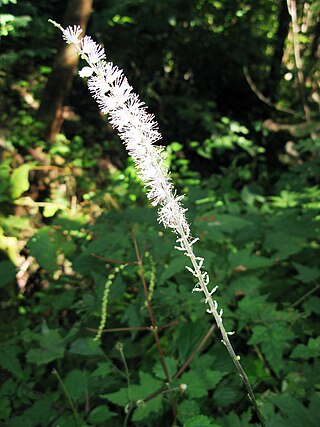
Actaea racemosa, the black cohosh, black bugbane, black snakeroot, rattle-top, or fairy candle, is a species of flowering plant of the family Ranunculaceae. It is native to eastern North America from the extreme south of Ontario to central Georgia, and west to Missouri and Arkansas. It grows in a variety of woodland habitats, and is often found in small woodland openings.

Actaea, commonly called baneberry, bugbane and cohosh, is a genus of flowering plants of the family Ranunculaceae, native to subtropical, temperate and subarctic regions of Europe, Asia and North America.

The Cimicifugeae are a tribe of flowering plants belonging to the family Ranunculaceae, based on the now obsolete genus Cimicifuga. The name Cimicifuga means "bed bug repeller".

Caulophyllum thalictroides, the blue cohosh, is a species of flowering plant in the Berberidaceae (barberry) family. It is a medium-tall perennial with blue berry-like fruits and bluish-green foliage. The common name cohosh is probably from an Algonquian word meaning "rough". The Greek-derived genus name Caulophyllum signifies "stem-leaf", while the specific name thalictroides references the similarity between the large highly divided, multiple-compound leaves of meadow-rues and those of blue cohosh.

Actaea pachypoda, the white baneberry or doll's-eyes, is a species of flowering plant in the genus Actaea, of the family Ranunculaceae.

Actaea rubra, the red baneberry or chinaberry, is a poisonous herbaceous flowering plant in the family Ranunculaceae, native to North America.
Black snakeroot may refer to:
Cohosh is a common name in the English language for several loosely related woodland herbs. The name may derive from Algonquian '*kkwὰhas', meaning 'rough', possibly describing leaves or compound flowers.

The Appalachian azure is a butterfly in the gossamer wings family Lycaenidae. The male is light blue on the upperwing with a narrow, dark line running along the edge of the forewing. The underwing is chalky white and is dotted with small, pale dark spots. The very back of the hindwing has a row of dark spots running along the edge and contained by a faint zigzagging band. Females are similar to the males but have broad dark wing borders instead of the male's narrow ones. The adult butterfly has a 1.1–1.4-inch (2.8–3.6 cm) wingspan. It is the largest azure in the area.

Trautvetteria caroliniensis is a species of flowering plant in the family Ranunculaceae native to North America. It is known by the common names Carolina bugbane, false bugbane, and tassel-rue. The genus is named for the botanist Ernst Rudolf von Trautvetter.

Oxytropis podocarpa is a species of flowering plant in the legume family known by the common names stalkpod locoweed, stalked-pod crazyweed, and Gray's point-vetch. It is native to North America, where it occurs in the northern latitudes, from Yukon and British Columbia across the low arctic to northern Quebec and Labrador. In the Rocky Mountains it occurs at the higher elevations as far south as Colorado.
Actaea arizonica is a species of flowering plant in the buttercup family known by the common name Arizona bugbane. It is endemic to Arizona in the United States, where it occurs in Coconino, Gila, and Yavapai Counties. Like some other species in genus Actaea, this plant was formerly included in the genus Cimicifuga.

N-Methylserotonin is a tryptamine alkaloid. Chemically, it is a derivative of serotonin in which a methyl group resides at its alkyl amine. It is also called Nω-methylserotonin (Nω-methyl-5-hydroxytryptamine) to distinguish it from tryptamine-derived compounds in which a methyl group is bonded to the nitrogen atom of the indole group.

Actaea elata is a species of flowering plant in the buttercup family known by the common name tall bugbane. It is native to the Pacific Northwest of North America, where it can be found in British Columbia, Washington, and Oregon.

Orbexilum pedunculatum, commonly known as Sampson's snakeroot, is a species of flowering plant in the legume family. It is native primarily to the Southeastern United States where it is found in prairies and savannas, often in acidic soil. It is a perennial that produces racemes of flowers in early summer.

Actaea simplex, the baneberry or bugbane, is a flowering plant in the buttercup family Ranunculaceae. A clump-forming rhizomatous herbaceous perennial, its native range includes the Kamchatka, Sakhalin and Siberian regions of Russia, western China, Manchuria, Mongolia, Korea and Japan. Plants may be harmful if eaten, and the sap may irritate the skin. The genus name Actaea is the Latin name adopted by Linnaeus from Pliny. The specific epithet simplex means simple or unbranched. The common name "bugbane" refers to the fact that the leaves' scent repels insects.

Actaea matsumurae, the Kamchatka bugbane or Japanese bugbane, is a species of flowering plant in the buttercup family Ranunculaceae, that is native to Japan, Mongolia and Eastern Russia. Other common names include baneberry, which is also applied to other Actaea species.

Actaea japonica, the Japanese bugbane, is a species of flowering plant in the family Ranunculaceae. It is native to central and southern China including Hainan, Jeju Island in South Korea, and central and southern Japan. A perennial, the Royal Horticultural Society considers it to be a good plant to attract pollinators.

Actaea rubifolia, commonly known as Appalachian black cohosh or Appalachian bugbane, is a species of flowering plant in the buttercup family. The plant does well in alkaline soils and mature forests. The "bugbane" in the name refers to the unpleasantness of its flowers' smell repelling insects. It is poisonous if consumed by humans.
















